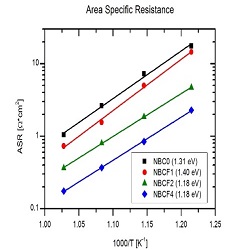
Renato Pelosato
Politecnico di Milano, Italy
Title: Doping strategies in NdBaCo2 O5+δ layered perovskites cathodes for IT-SOFCs
Biography
Biography: Renato Pelosato
Abstract
Co-based layered perovskites (LnBaCo2O5+d Ln=Lanthanides or Y) have been recently proposed as cathode materials for IT-SOFCS. These compounds crystallize in a double perovskite structure (LnCoO3-δ–BaCoO3-δ), where Ln and Ba ions sit on alternated single perovskite layers. Pr, Nd and Gd based compounds show the best performance, likely due to their optimum ion size. Recently, chemical modifications like cation deficiency and Co substitution have gained interest as a way to tailor the defect chemistry of these materials. The effect of Fe-doping on the B-site and of Ba deficiency on the A-site has been investigated. XRD, TG-DTA, ICP-MS and cerimetric titrations were performed to assess the phase composition, crystal structure, chemical composition and oxygen content. The electrochemical properties were investigated via 4-probe electrical conductivity measurements and electrochemical impedance spectroscopy on symmetrical cells with GDC electrolyte. All the compounds show high total electrical conductivity (between 400 and 600 S/cm at 700°C). A tenfold decrease of the area specific resistance is observed at increasing Ba deficiency to 10%. Detailed equivalent circuit analysis reveals that the effect of Ba is associated with a promotion of the bulk diffusion steps at high frequency. On the other hand, iron substitution triggers a structural change from orthorhombic to tetragonal, and lowers the electrical conductivity. The compound with 20% of iron shows the lowest polarization resistance (0.17 Ω*cm2 at 700°C). The ORR mechanism investigated by ECM and physical 1D modeling shows that the first electronation of the oxygen atom on the MIEC surface and the bulk diffusion of the oxygen vacancies in the MIEC lattice are the rate determining steps.


Figure 1: ASR of NBC material in symmetric cells with GDC electrolyte. Effect of increasing Ba deficiency (left) and increasing Iron doping (right)
Recent Publications:
1. A. Tarancón, S. J. Skinner, R. J. Chater, F. Hernández-Ramírez and J. A. Kilner, Journal of Materials Chemistry, 2007, 17, 3175. http://dx.doi.org/10.1039/b704320a
2. R. Pelosato, G. Cordaro, D. Stucchi, C. Cristiani and G. Dotelli, Journal of Power Sources, 2015, 298, 46. http://dx.doi.org/10.1016/j.jpowsour.2015.08.034
3. S. Pang, X. Jiang, X. Li, Q. Wang, Z. Su, J. Power Sources, 204 (2012) 53-59. http://dx.doi.org/10.1016/j.jpowsour.2012.01.034
4. F. Jin, H. Xu, W. Long, Y. Shen, T. He, J. Power Sources 2013, 243, 10. http://dx.doi.org/10.1016/j.jpowsour.2013.05.187
5. A. Donazzi, R. Pelosato, G. Cordaro, D. Stucchi, C. Cristiani, G. Dotelli, I.N. Sora, Electrochim. Acta, 182 (2015) 573-587. http://dx.doi.org/10.1016/j.electacta.2015.09.117

